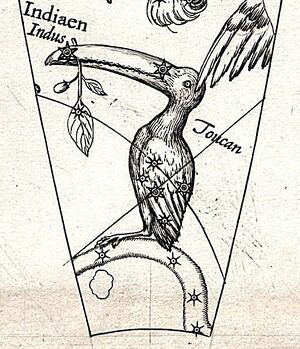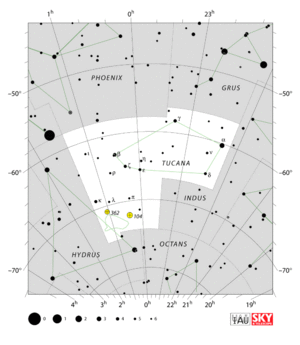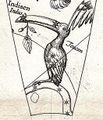Tucana: Difference between revisions
(added image from Cheung Sze Leung and Youla Azkarrula) |
|||
| Line 15: | Line 15: | ||
==== Indigenous importance ==== |
==== Indigenous importance ==== |
||
| ⚫ | |||
In the Indonesian language, the bird is called "Burung Enggang" or "Burung Rangkong." Renowned on the island of Borneo, this human-friendly hornbill is closely associated with the Dayak people. In Dayak philosophy, the bird holds great significance and is deeply embedded in their culture and local wisdom. The hornbill symbolises the close connection of the Indonesian people to their natural surroundings. Its entire body represents the greatness and glory of the tribe, symbolising peace and unity, with its thick wings denoting a leader who always protects his people. The long tail is viewed as a sign of the prosperity of the Dayak people. Moreover, the hornbill serves as an example of family life in the community, teaching them always to love their partners and raise their children to become independent and mature Dayaks. |
In the Indonesian language, the bird is called "Burung Enggang" or "Burung Rangkong." Renowned on the island of Borneo, this human-friendly hornbill is closely associated with the Dayak people. In Dayak philosophy, the bird holds great significance and is deeply embedded in their culture and local wisdom. The hornbill symbolises the close connection of the Indonesian people to their natural surroundings. Its entire body represents the greatness and glory of the tribe, symbolising peace and unity, with its thick wings denoting a leader who always protects his people. The long tail is viewed as a sign of the prosperity of the Dayak people. Moreover, the hornbill serves as an example of family life in the community, teaching them always to love their partners and raise their children to become independent and mature Dayaks. |
||
<gallery> |
|||
| ⚫ | |||
File:Talawang-Perisai-Tradisi-Suku-Dayak-941x480.jpg|Dayak tribal magical shield which has a picture of a hornbill in the carving (Youla Azkarrula 2024) |
|||
| ⚫ | |||
</gallery> |
|||
| ⚫ | |||
A Dayak story from Kalimantan reports that hornbills are the incarnation of the Bird Commander. Panglima Burung is a figure who lives in the mountains of inland Kalimantan and has a magical form and will only be present during war. In general, this bird is considered sacred and is not allowed to be hunted or eaten. Even today, the government protects this species by law. |
A Dayak story from Kalimantan reports that hornbills are the incarnation of the Bird Commander. Panglima Burung is a figure who lives in the mountains of inland Kalimantan and has a magical form and will only be present during war. In general, this bird is considered sacred and is not allowed to be hunted or eaten. Even today, the government protects this species by law. |
||
=== |
===Possible origins of the interpretation of a Toucan=== |
||
Toucans are not home to the East Indies and Malaysia. It has been suggested that images like this lead to the new interpretation of the constellation as a Toucan, although de Houtman certainly did not describe a toucan but an hornbill (cf. Smith 2007<ref>Smith, Paul J., "On Toucans and Hornbills: Readings in Early Modern Ornithology from Belon to Buffon", in: K.A.E. Enenkel & P.J. Smith (eds.), ''Early Modern Zoology: The Construction of Animals in Science, Literature and the Visual Arts'' (Leiden: Brill, 2007) 75–119 [[https://doi.org/10.1163/ej.9789004131880.i-657.24 doi link]].</ref> and Ridpath). |
Toucans are not home to the East Indies and Malaysia. It has been suggested that images like this lead to the new interpretation of the constellation as a Toucan, although de Houtman certainly did not describe a toucan but an hornbill (cf. Smith 2007<ref>Smith, Paul J., "On Toucans and Hornbills: Readings in Early Modern Ornithology from Belon to Buffon", in: K.A.E. Enenkel & P.J. Smith (eds.), ''Early Modern Zoology: The Construction of Animals in Science, Literature and the Visual Arts'' (Leiden: Brill, 2007) 75–119 [[https://doi.org/10.1163/ej.9789004131880.i-657.24 doi link]].</ref> and Ridpath). |
||
[http://www.ianridpath.com/startales/tucana.html Ridpath] suggests that the inventor of this constellation was actually Pieter Keyser who had not survived the expedition to the East Indies but had previously visited South America. Hoffmann (2021, 108) suggests Plancius and de Houtman as also possible because baroque ‘wunderkamers’ could certainly have played a mediating role here. Rob van Gent here adds that is not necessary that Keyser, de Houtman or Plancius actually saw a live (or dead) toucan as they are bound to descriptions and depictions of the bird in 16th-century travel literature: in particular Plancius would surely have been familiar with these. |
[http://www.ianridpath.com/startales/tucana.html Ridpath] suggests that the inventor of this constellation was actually Pieter Keyser who had not survived the expedition to the East Indies but had previously visited South America. Hoffmann (2021, 108) suggests Plancius and de Houtman as also possible because baroque ‘wunderkamers’ could certainly have played a mediating role here. Rob van Gent here adds that is not necessary that Keyser, de Houtman or Plancius actually saw a live (or dead) toucan as they are bound to descriptions and depictions of the bird in 16th-century travel literature: in particular Plancius would surely have been familiar with these. |
||
=== |
===Versions in early modern celestial maps=== |
||
<gallery> |
<gallery> |
||
File:Toucan plancius1598.jpg|Plancius' Toucan (1598) |
File:Toucan plancius1598.jpg|Plancius' Toucan (1598) |
||
| Line 39: | Line 44: | ||
</gallery> |
</gallery> |
||
== Modern Star Name |
== Modern Star Name== |
||
"Exster" is proposed as name for the main star of the modern IAU-constellation of Tucana (alf Tuc). |
"Exster" is proposed as name for the main star of the modern IAU-constellation of Tucana (alf Tuc). |
||
| Line 45: | Line 50: | ||
(or vice versa?) |
(or vice versa?) |
||
== |
==References== |
||
* |
*Ian Ridpath, Star Tales. [http://www.ianridpath.com/startales/tucana.html website] |
||
[[Category:Eurasia]] |
[[Category:Eurasia]] |
||
[[Category:European]] |
[[Category:European]] |
||
[[Category:Modern]] |
[[Category:Modern]] |
||
<references /> |
|||
Revision as of 09:20, 11 July 2024
"den Indiaenschen Exster, op Indies Lang ghenaemt" (the Indian Magpie, known as "Lang" in the Indies) was the original Dutch name of the constellation of the bird that is now called "Toucan" (Tucana, Tuc). The constellation was invented by Pieter Dircksz Keyser and Frederik de Houtman on their journey to Indonesia in 1595/6.
Invention & Transformation
The southern star catalog by de Houtman[1] and Keyser was published by de Houtman in 1603 as an appendix to a dictionary of the Malaysian (and other) language(s). This star catalog was written in Dutch (with later translations to French,[2] English[3][4] and Spanish[5]). This printed catalogue of 1603 was made from observations collected by de Houtman on his second voyage (1598-1602) and during the two-year period when he was held as a hostage by the Sultan of Aceh on Northern Sumatra. At that time, de Houtman worked for W.J. Blaeu, a Plancius competitor, who used the data on his celestial globe of 1603.
Before the publication of his star catalogue, de Houtman had shared the data from the first voyage (1595/6) with Petrus Plancius who had actually commissioned this work. Plancius used the data collected by Pieter Dircksz Keyser on the exploration "Eerste Schipvaart" ('de eerste schipvaart op Oost-Indie'); De Houtman may have assisted in making these observations, and as Keyser was buried on the island of Java, de Houtman may also have been the person who personally communicated Keyser’s data to Plancius in 1597, but this is nowhere explicitly stated, it is just assumed because Plancius had worked with this material, and his celestial globe of 1598 already displayed paintings of the newly invented constellations in the south. The images had the labels "Indian" and "Toucan" left and right of the bird, while the left label ("Indian") also referred to the male figure northwest of it. Petrus Plancius' work and/or its copies by W. J. Blaeu served as source for Bayer's Uranometria (1603). Bayer's map of the south pole also displays the image with the label "Toucan" and an extraordinarily long beak.
Species of this bird
The additional phrase in de Houtman's catalog, mentioning that the bird was named "Lang" is occasionally misinterpreted to be the cause for this depiction, implying that "Lang" in Dutch means "long" and refers to the beak. In de Houtman's days the Dutch word for long was usually spelled as "lanck", so "Lang" is actually the name of the bird in the Malay language (cf. Maass 1926)[6]. According to the Malay-English Dictionary (1901), it is the a generic term for birds of prey such as hawks, kites, falcons and eagles.
The hornbill's beak and crown start off white, but they may gradually turn orange and red because the hornbill rubs its beak against a gland. Although hornbills' favorite food is fig leaves, they also commonly eat insects, mice, lizards, and small birds.
Indigenous importance
In the Indonesian language, the bird is called "Burung Enggang" or "Burung Rangkong." Renowned on the island of Borneo, this human-friendly hornbill is closely associated with the Dayak people. In Dayak philosophy, the bird holds great significance and is deeply embedded in their culture and local wisdom. The hornbill symbolises the close connection of the Indonesian people to their natural surroundings. Its entire body represents the greatness and glory of the tribe, symbolising peace and unity, with its thick wings denoting a leader who always protects his people. The long tail is viewed as a sign of the prosperity of the Dayak people. Moreover, the hornbill serves as an example of family life in the community, teaching them always to love their partners and raise their children to become independent and mature Dayaks.
Mythology
A Dayak story from Kalimantan reports that hornbills are the incarnation of the Bird Commander. Panglima Burung is a figure who lives in the mountains of inland Kalimantan and has a magical form and will only be present during war. In general, this bird is considered sacred and is not allowed to be hunted or eaten. Even today, the government protects this species by law.
Possible origins of the interpretation of a Toucan
Toucans are not home to the East Indies and Malaysia. It has been suggested that images like this lead to the new interpretation of the constellation as a Toucan, although de Houtman certainly did not describe a toucan but an hornbill (cf. Smith 2007[7] and Ridpath).
Ridpath suggests that the inventor of this constellation was actually Pieter Keyser who had not survived the expedition to the East Indies but had previously visited South America. Hoffmann (2021, 108) suggests Plancius and de Houtman as also possible because baroque ‘wunderkamers’ could certainly have played a mediating role here. Rob van Gent here adds that is not necessary that Keyser, de Houtman or Plancius actually saw a live (or dead) toucan as they are bound to descriptions and depictions of the bird in 16th-century travel literature: in particular Plancius would surely have been familiar with these.
Versions in early modern celestial maps
Modern Star Name
"Exster" is proposed as name for the main star of the modern IAU-constellation of Tucana (alf Tuc).
"Lang" is proposed as name for beta Tuc.
(or vice versa?)
References
- Ian Ridpath, Star Tales. website
- ↑ Frederik de Houtman (1603) Star Catalogue concerning the Indian Magpie
- ↑ Marre, Aristide, “Catalogue des étoiles circumpolaires australes observées dans l'Ile de Sumatra”, Bulletin sciences mathématiques et astronomiques, 1 (1881), 336–352 [ADS link].
- ↑ Knobel, Edward Ball, “On Frederick de Houtman's catalogue of southern stars, and the origin of the southern constellations”, Monthly Notices of the Royal Astronomical Society, 77 (1917), 414–432 [doi link / ADS link].
- ↑ Knobel, Edward Ball, “Note on the paper 'On Frederick de Houtman's catalogue of southern stars, and the origin of the southern constellations' ", Monthly Notices of the Royal Astronomical Society, 77 (1917), 580 [doi link / ADS link].
- ↑ Selga, Miguel, "Un catálogo antiguo de estrellas australes", Revista de la Sociedad Astronómica de España y América, 8 (1918), 84-90 & 9 (1919), 11, 44-46 & 62-63 [online link(?)].
- ↑ Maass, Alfred, "Sternkunde und Sterndeuterei im malaiischen Archipel", Tijdschrift voor Indische Taal-, Land- en Volkenkunde, 64 (1924), 1-172 & 347-459 [online link], with a "Nachtrag", 66 (1926), 618-670 [online link].
- ↑ Smith, Paul J., "On Toucans and Hornbills: Readings in Early Modern Ornithology from Belon to Buffon", in: K.A.E. Enenkel & P.J. Smith (eds.), Early Modern Zoology: The Construction of Animals in Science, Literature and the Visual Arts (Leiden: Brill, 2007) 75–119 [doi link].

















